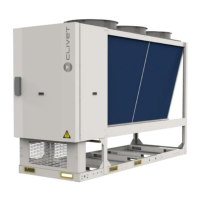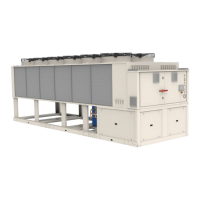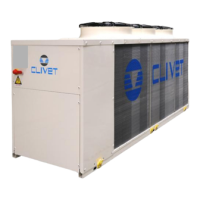Do you have a question about the CLIVET WSAN-YES 35.2 and is the answer not in the manual?
Covers manual use, safety, intended purpose, and preliminary checks.
Guidance on installation, maintenance, modifications, breakdowns, and user training.
User info, unit identification, refrigerant data, serial number, and intervention requests.
Procedures for receiving, inspecting, and storing the unit.
Safe handling procedures and packaging removal instructions.
Guidelines for unit placement, functional spaces, and air circulation.
Advice on unit placement to ensure proper airflow and avoid issues.
Guidance on pressure relief valves, condensate, and anti-vibration mounts.
Details on anti-vibration mounts and their corresponding codes.
Information on optional protection grilles.
Guidance on hydraulic systems, water quality, and freeze protection.
Information on water flow-rate, system content, and water filter specifications.
Schematics for standard, pump, and storage tank unit connections.
Details on DHW option, sensors, compressor thresholds, and wiring.
Installation of TW probe and configuration of modular units.
Managing domestic hot water in modular unit setups.
Details on optional kits and fittings for modular units.
Instructions for using spacers between modular units.
Steps for starting the unit pump and water connection types.
General electrical installation requirements and safety precautions.
Information on electrical data, serial label, and connection procedures.
Guidelines for signal/data lines, power input, and remote ON-OFF.
Proper usage of the disconnector.
Diagram and labels for customer electrical connections.
Setup for remote control and modular unit configuration.
Procedure for addressing units in modular setups.
Addressing controls for units in modular configurations.
Wiring diagram for main and auxiliary units in modular configurations.
Overview of Modbus functionality, RS-485 specs, and connections.
Setting unit addresses and Modbus register data.
Detailed Modbus registers for standard and modular unit configurations.
Further Modbus registers for unit parameters and status.
Registers for querying unit status and data.
Mapping of Modbus error codes to decimal values.
General start-up procedures, preliminary checks, and refrigerant circuit overview.
Procedures for water circuit checks and the unit start-up sequence.
Guidance on antifreeze, electrical checks, and remote controls.
Pump start test, heater checks, voltage checks, and flow rate verification.
Checking pressure drops, scroll compressor, and reduced load operation.
Required start-up data, PED directive, and certification information.
Start-up logic for units in multiple configurations (cooling and heating).
Explains the functions of the control panel buttons and navigation.
Accessing the password-protected service menu on slave controllers.
Explanation of various icons and indicators on the control panel display.
Note on displayed information referring to the MASTER unit.
General navigation, screen lockout, and setting mode/temperature.
Navigating the user menu to access various settings.
Using the query function to view unit data in networked systems.
Selecting timer categories within the user menu.
Configuring daily/weekly timers and date/time settings.
Selecting and saving silent mode settings.
Configuring double setpoint and temperature compensation for cooling/heating.
Configuring DHW settings for single and modular units.
Setting minimum and maximum operating times for modes.
Controlling auxiliary heaters for domestic hot water storage.
Alarm reset, master unit protection, and temperature sensor fault diagnosis.
Handling slave unit protection and communication errors.
Troubleshooting EEPROM, phase sequence, and communication faults.
Diagnosing faults related to sensors, flow, and antifreeze protection.
Troubleshooting errors related to pressure, compressor, and module faults.
Resolving errors related to valves, fans, protection, and module issues.
Troubleshooting errors related to phase frequency, gate, and defrosting.
Interpreting status codes displayed on DSP1 and DSP2.
Troubleshooting status codes for DC voltage, frequency, EPROM, and defrosting.
Crucial safety precautions for maintenance on R32 units.
Checks for cooling components, electrical devices, and component repair.
Initial safety checks and refrigerant handling precautions.
Safety for component handling, wires, and detecting flammable refrigerants.
Methods for leak detection and procedures for refrigerant recovery.
Safety for brazing, charging, dismantling, and refrigerant recovery.
Best practices for refrigerant recovery and equipment labelling.
Guidelines for transporting, marking, storing, and disposing of equipment.
General maintenance rules and safety for R32 refrigerant.
Steps for refrigeration circuit work and R32 refrigerant properties.
Inspection frequency, environmental factors, and maintenance schedule.
Unit booklet, standby mode, and system drain procedures.
Checks on compressor casing heaters and restart procedures.
Maintenance for water exchangers, filters, insulations, and air coils.
Maintenance for pressure valves, pumps, fans, and structure.
Diagrams illustrating exchanger, compressor, and pump replacement.
Disconnection, environmental protection, and WEEE disposal information.
Identifying general risks, danger zones, and handling/installation hazards.
Risks from electrical components, earthing, and accessible parts.
Risks from energized/moving parts, refrigerants, and hydraulic components.
Detailed dimensions and specifications for sizes 18.2 and 20.2.
Detailed dimensions and specifications for sizes 25.2, 30.2, and 35.2.
Performance data for radiant panels, terminal units, and radiators.
AHRI data, product compliance, and refrigerant information.
Technical details on construction, compressors, exchangers, and fans.
Water circuit data, power supply, and control device calibrations.
Table of admissible water flow rates for unit operation.
Sound levels for different operating modes and maximum conditions.
Graphs showing normal operating ranges for cooling and heating.
Covers manual use, safety, intended purpose, and preliminary checks.
Guidance on installation, maintenance, modifications, breakdowns, and user training.
User info, unit identification, refrigerant data, serial number, and intervention requests.
Procedures for receiving, inspecting, and storing the unit.
Safe handling procedures and packaging removal instructions.
Guidelines for unit placement, functional spaces, and air circulation.
Advice on unit placement to ensure proper airflow and avoid issues.
Guidance on pressure relief valves, condensate, and anti-vibration mounts.
Details on anti-vibration mounts and their corresponding codes.
Information on optional protection grilles.
Guidance on hydraulic systems, water quality, and freeze protection.
Information on water flow-rate, system content, and water filter specifications.
Schematics for standard, pump, and storage tank unit connections.
Details on DHW option, sensors, compressor thresholds, and wiring.
Installation of TW probe and configuration of modular units.
Managing domestic hot water in modular unit setups.
Details on optional kits and fittings for modular units.
Instructions for using spacers between modular units.
Steps for starting the unit pump and water connection types.
General electrical installation requirements and safety precautions.
Information on electrical data, serial label, and connection procedures.
Guidelines for signal/data lines, power input, and remote ON-OFF.
Proper usage of the disconnector.
Diagram and labels for customer electrical connections.
Setup for remote control and modular unit configuration.
Procedure for addressing units in modular setups.
Addressing controls for units in modular configurations.
Wiring diagram for main and auxiliary units in modular configurations.
Overview of Modbus functionality, RS-485 specs, and connections.
Setting unit addresses and Modbus register data.
Detailed Modbus registers for standard and modular unit configurations.
Further Modbus registers for unit parameters and status.
Registers for querying unit status and data.
Mapping of Modbus error codes to decimal values.
General start-up procedures, preliminary checks, and refrigerant circuit overview.
Procedures for water circuit checks and the unit start-up sequence.
Guidance on antifreeze, electrical checks, and remote controls.
Pump start test, heater checks, voltage checks, and flow rate verification.
Checking pressure drops, scroll compressor, and reduced load operation.
Required start-up data, PED directive, and certification information.
Start-up logic for units in multiple configurations (cooling and heating).
Explains the functions of the control panel buttons and navigation.
Accessing the password-protected service menu on slave controllers.
Explanation of various icons and indicators on the control panel display.
Note on displayed information referring to the MASTER unit.
General navigation, screen lockout, and setting mode/temperature.
Navigating the user menu to access various settings.
Using the query function to view unit data in networked systems.
Selecting timer categories within the user menu.
Configuring daily/weekly timers and date/time settings.
Selecting and saving silent mode settings.
Configuring double setpoint and temperature compensation for cooling/heating.
Configuring DHW settings for single and modular units.
Setting minimum and maximum operating times for modes.
Controlling auxiliary heaters for domestic hot water storage.
Alarm reset, master unit protection, and temperature sensor fault diagnosis.
Handling slave unit protection and communication errors.
Troubleshooting EEPROM, phase sequence, and communication faults.
Diagnosing faults related to sensors, flow, and antifreeze protection.
Troubleshooting errors related to pressure, compressor, and module faults.
Resolving errors related to valves, fans, protection, and module issues.
Troubleshooting errors related to phase frequency, gate, and defrosting.
Interpreting status codes displayed on DSP1 and DSP2.
Troubleshooting status codes for DC voltage, frequency, EPROM, and defrosting.
Crucial safety precautions for maintenance on R32 units.
Checks for cooling components, electrical devices, and component repair.
Initial safety checks and refrigerant handling precautions.
Safety for component handling, wires, and detecting flammable refrigerants.
Methods for leak detection and procedures for refrigerant recovery.
Safety for brazing, charging, dismantling, and refrigerant recovery.
Best practices for refrigerant recovery and equipment labelling.
Guidelines for transporting, marking, storing, and disposing of equipment.
General maintenance rules and safety for R32 refrigerant.
Steps for refrigeration circuit work and R32 refrigerant properties.
Inspection frequency, environmental factors, and maintenance schedule.
Unit booklet, standby mode, and system drain procedures.
Checks on compressor casing heaters and restart procedures.
Maintenance for water exchangers, filters, insulations, and air coils.
Maintenance for pressure valves, pumps, fans, and structure.
Diagrams illustrating exchanger, compressor, and pump replacement.
Disconnection, environmental protection, and WEEE disposal information.
Identifying general risks, danger zones, and handling/installation hazards.
Risks from electrical components, earthing, and accessible parts.
Risks from energized/moving parts, refrigerants, and hydraulic components.
Detailed dimensions and specifications for sizes 18.2 and 20.2.
Detailed dimensions and specifications for sizes 25.2, 30.2, and 35.2.
Performance data for radiant panels, terminal units, and radiators.
AHRI data, product compliance, and refrigerant information.
Technical details on construction, compressors, exchangers, and fans.
Water circuit data, power supply, and control device calibrations.
Table of admissible water flow rates for unit operation.
Sound levels for different operating modes and maximum conditions.
Graphs showing normal operating ranges for cooling and heating.











